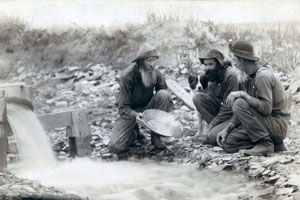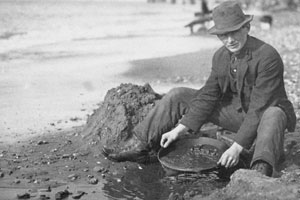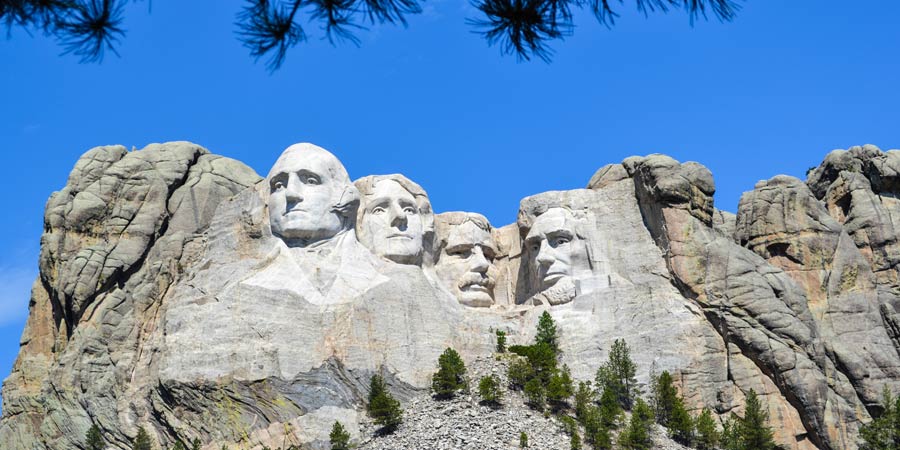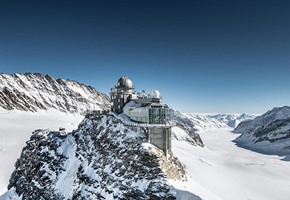Winding through the rocky gorges of South Dakota, the Black Hills Central Railroad is one of the most famous railroad trips in the USA, tracing the route taken by miners during America's nineteenth-century gold rush. Rumours of gold in the Black Hills were wide spread in the 1800s, with prospectors willing to travel from all over the country for their chance at the American dream.
Prospecting in South Dakota

In the 1800s, gold was the key to the American Dream, a path to instant riches. All that needed to be done was to pluck it out of the ground.
The first gold strike in the United States was in 1948, in California and hopeful prospectors flooded to the state. The gold was soon exhausted, and miners headed back into the west looking for the next opportunity to strike it rich. Gold was found in Arizona, Colorado, Montana and Idaho, one place as yet unexplored were the Black Hills of South Dakota. The Black Hills were sacred to the Sioux Indians who had lived there for centuries. In 1869, the Lakota Sioux made an agreement with the new settlers. Giving up their right of free movement on the Great Plains, they were compensated with the promise the land of the Black Hills would remain theirs 'as long as grass should grow and rivers flow'.
The first prospectors saw the Black Hills, and the precious yellow metal they contained as their god given right to wealth. They disagreed with the treaty, viewed it as an obstacle to civilization and believed the Lakota Sioux to be nothing more than savages. The army were tasked with enforcing the treaty and keeping the prospectors out. In 1874, the army undertook a six hundred man strong mapping expedition, led by the infamous General Custer, into the Black Hills. This expedition was to confirm the presence of gold in the Black Hills. While he only mentioned the discovery of gold in passing in his official report, Custer had five newspaper reporters accompany him. Soon newspapers around the country were telling stories of a 'new El Dorado' to be found in the Black Hills and sparked the Black Hills Gold rush.
The race to the hills

In 1872, the first trackage was laid for the new railroad in South Dakota, heading towards the Black Hills. The first wave of prospectors to the area arrived by river, and plans were continually discussed for new railroads to be laid, or current tracks to be extended. It was finally decided the railroad should connect with existing tracks in Iowa. The new railroad was laid to Yankton, and prospectors began flooding into the area to find their fortune. As the population in the Black Hills grew and gold mines became profitable it was realised the first railroad to reach the hills would be a profitable one.
In other parts of the American West, towns had sprung up after the railways were built, but prospectors were already living and mining the Black Hills. Two railroad companies were pitted against each other in the race to be the first to reach the gold mines of the hills. However, much of South Dakota was still deemed part of the Great Sioux Reservation, and neither company gained permission to lay tracks on the land.
Frustrated by the lack of progress the Homestake Mining Company, the dominant economic force in the area, took it upon themselves to solve the problem. The Black Hills and Fort Pierre Railroad was constructed, with their first steam engine hauled by ox team across the plains. The line mainly transported timber to the Homestake's mines, and only ran through the Black Hills. A second line was also built, again without the assistance of large railroad companies that connected local townships Lead and Deadwood.
In the early 1880s the North Western Railroad Company acquired a short railroad line in Nabraska. They quickly realised a route into the Black Hills that would by-pass the Sioxu reservation, and construction began immediately and the line. The track finally reached Deadwood and was completed in late 1890. At the same time the Chicago Burlington & Quincy (the 'Burlington') was also rapidly expanding its railway network. The Burlington built a branch of their railroad through the center of the Black Hills and reached Deadwood just a month after North Western. The Burlington were quick to purchase the local railroads and soon owned the majority share of the Black Hills railroads.
The Chicago Burlington & Quincy Railroad continued laying tracks throughout the 1880s and the line reached Keystone in 1900. This same line was later used to haul equipment needed for carving the close by Mt Rushmore.
The Railroad Today
Today the famous '1880s Train' gives visitors a sense of what it was like for the first prospectors travelling on the railroad through the Black Hills. The vintage Steam train runs on original rail bed laid in the 1800s, and is the oldest continuously operating steam train in the United States.
In 1957, the Black Hills Central Railroad took over the line, and gave tourists a chance to experience one of the most scenic tours in the USA for themselves. The Black Hills Central Railroad's steam locomotive fleet includes the recently restored 2-6-6-2T Mallet, and also includes ten passenger cars along with a caboose and a rare waycar. Most of these cars date back to the 19th century and have been beautifully restored making the trip that much more enjoyable.
If you've been inspired to take one of our touring holidays in the USA, or explore the American Wild West we offer a number of different rail tours in the USA.





